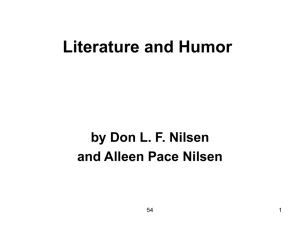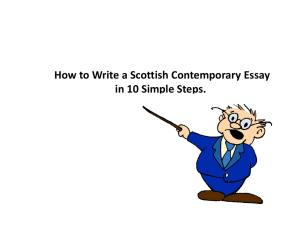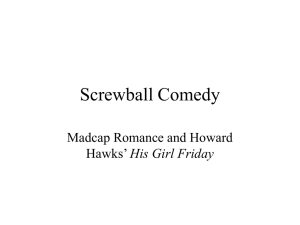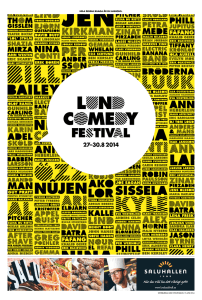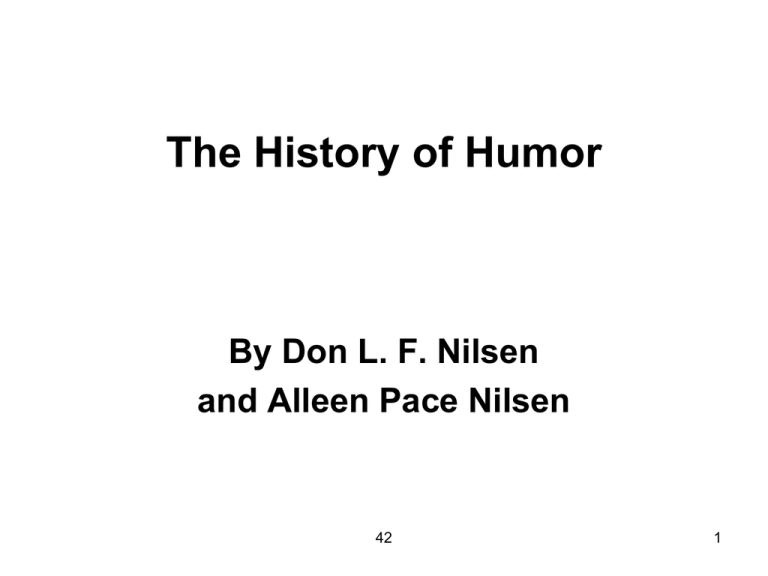
The History of Humor
By Don L. F. Nilsen
and Alleen Pace Nilsen
42
1
Two Visual Anachronisms
42
2
42
3
The History of Comedy
• “Greek comedies were often bawdy or
ribald and ended happily for everyone.”
• “To Chaucer, Shakespeare, and other
writers of the Middle Ages and
Renaissance, a comedy was a story
(but especially a play) with a happy
ending, whether humorous or not.
• (Triezenberg [2008]: 525)
42
4
Homer (9th-8th Century BC)
• “Aristotle’s Poetics, includes Homer in his
discussion of the comic:”
• “A poem of the satirical kind cannot indeed
be put down to any author earlier than
Homer; though many such writers probably
there were.”
• “But from Homer onward, instances can be
cited—his own Margites, for example.”
• Triezenberg [2008]: 525)
42
5
Old Comedy, Middle Comedy and New Comedy
• Old Comedy of the 6th & 5th Centuries BC often made
fun of a specific person and of current political
issues.
• Middle Comedy of the 5th & 4th Centuries BC made
fun of more general themes such as literature,
professions, and society.
• New Comedy of the 4th & 3rd Centuries BC usually
revolved around “the bawdy adventures of a
blustering soldier, a young man in love with an
unsuitable woman, or a father figure who cannot
follow his own advice.”
(Triezenberg [2008]:
525)
42
6
Aristophanes (c450-c388 BC)
• “Of the Old and Middle comedies, the only ones that have
survived complete are eleven plays of Aristophanes.”
• “The Clouds lampoons Socrates in heaven, in the Old tradition,
while Lysistrata makes fun of human nature in general.”
• In Plutus both the wealth and the poverty in Athens are
personified. The citizenry are so distracted that they neglect
the gods.
• Plutus is considered to be Middle comedy.
• (Triezenberg [2008]: 525)
42
7
Titus Maccius Plautus (c254-184 BC)
Plubius Terentius Terence (185-c159 BC)
• “Comedy in the Roman Empire is generally
reduced to the works of Plautus and Terence,
the former of whom lived at about the same
time as Menander, the latter about a century
later.”
• Both Plautus and Terence wrote plays of the
old Greek sort—“farces involving the same
stock characters (father, soldier, slave) and
which, unlike the plays of Aristophanes,
offended no on in particular.”
• (Triezenberg [2008]: 526)
42
8
Menander (fl. 160-135 BC)
• “The author of New comedy whose work has
best survived the ages is Menander.”
• Menander’s Dyskolos (The Grouch) was
discovered in 1957.
• “Many other long pieces of Menander’s work
have survived in Latin translations by
Terence and Plautus.”
• (Triezenberg [2008]: 525)
42
9
Dante Alighieri (1265-1321)
• Most of Dante’s “The Divine Comedy” is not at all funny.
• It is about “Paradiso” as contrasted with “Purgatorio” and the
“Inferno.”
• It was called a comedy because it is “a story about the
powerless vs. the powerful, or the little man vs. the big man, or
even about the perils and pitfalls of social pretence.”
• And thus, “The Divine Comedy” was indeed a “comedy” only in
the classical sense of the word.
(Triezenberg [2008]: 525)
42
10
• “The Inferno, the first installment of
Dante’s The Divine Comedy, describes
damned souls engaging in bawdy
behavior and word play.”
• The second and third installments of
The Divine Comedy are however
distinctly not funny, and demonstrate
that in the fourteenth century “a
comedy need do nothing more than end
happily”
(Triezenberg [2008]: 526).
42
11
Giovanni Boccaccio (1313-1375)
• Boccaccio’s Decameron is “a collection of
stories told by a group of ten nobles who
have fled the Black Death by shutting
themselves up in a lonely castle.”
• Chaucer’s Canterbury Tales were influenced
by Boccaccio’s Decameron, and they have
basically the same structure.
• (Triezenberg [2008]: 526)
42
12
Geoffrey Chaucer (c1342-1400)
• “In the Middle Ages, the farces, bawdies, and
satires of Greek and Roman literature
continued to be popular.”
• “Chaucer is best known for his Canterbury
Tales, some of which (e.g. The Miller’s Tale)
are both bawdy and still funny by today’s
standards.”
• (Triezenberg [2008]: 526)
42
13
• “Chaucer also penned The Romaunt of
the Rose, a satire on love and courtship,
and The House of Fame which seems to
spoof Dante’s idea of the narrator and
the guide.”
• “In Chaucer’s version, the narrator
would rather not listen to the guide.”
• (Triezenberg [2008]: 526)
42
14
Erasmus (1466-1536)
• “Erasmus has very clear political and
religious objectives in The Praise of Folly,
where Folly is nursed and instructed by Self
Love, Flattery, Intemperance, and a number
of other personified sins, and goes on to
criticize the Catholic Church.”
• “Oddly enough, the joke was on Erasmus,
who was a staunch Catholic, but whose work
became a major catalyst of the Protestant
Reformation.”
(Triezenberg [2008]: 527)
42
15
François Rabelais (c1483-1553)
• Rabelais published a series of five books
collectively known as Gargantua and
Pantagruel.
• “Gargantua and his son Pantagruel are two
giants of unfixed size, who can sometimes fit
into a normal building and sometimes hold
whole civilizations inside of their mouths.”
• Triezenberg [2008]: 526)
42
16
“These books contain satires on the
Roman Catholic church, bawdy stories,
and scatological humor as well as plain
silliness that reminds the modern reader
of Monty Python’s Flying Circus.
• “Rabelais’ brand of silliness and
freedom from the laws of physics and of
logic was discussed by the critic
Bakhtin, who calls this atmosphere the
‘carnival’ world.”
(Triezenberg [2008]: 526)
42
17
William Shakespeare (1564-1616)
• “Shakespeare’s plays are sometimes divided into
Comedy, Tragedy, and History.”
• “The history plays are, obviously, those based on
historical personages such as Richard III and Henry
IV.”
• “The difference between comedy and tragedy is still
very much the same as in Greek plays—comedies
have happy endings and tragedies have sad ones;
tragic heroes are larger than life, while comic heroes
are flawed.”
• (Triezenberg [2008]: 527)
42
18
• “Shakespeare’s comedies are also usually
funny, but unlike the Greek bawdy plays and
satires, their humor lies in word play—puns,
allusions, and double-entendres that are very
often lost on today’s audience.”
• “Careful perusal of an annotated version of
Love’s Labours Lost or All’s Well That Ends
Well will reveal the surprising density of jokes
in these plays, which are supposed to have
had Elizabethan audiences roaring with
laughter”
(Triezenberg [2008]: 527).
42
19
• Falstaff, a great comic and humorous
character demonstrates Bakhtin’s “carnival.”
• Falstaff appears not in comedy plays, but in
history plays--Henry IV parts I and II.
• Shakespeare’s tragedies, too, often include a
figure of a clown or fool. His job is not so
much to provide mirth or laughter as it is to
provide commentary that is sometimes satiric
and very often funny.
• (Triezenberg [2008]: 527)
42
20
Court Jesters: From the Middle Ages to the Renaissance
During the Middle Ages the kings
had court jesters.
The jester’s septer was a
ludicrous representation of the
king’s septer, which represented
power.
Because They were not supposed
to be in competition with the king,
they tended to be deformed
In Shakespeare’s plays, the
midgets with humped backs and
king’s fool represents these
bug eyes.
midieval traditions.
And they were not very smart.
But in King Lear the fool is
smarter than the king.
They also wore cap and bells and
motley clothes, and funny shoes.
And they carried the “jester’s
septer” containing an image of
the jester’s face.
42
And often smart fools, because
they were so “marked” could say
things to the king that noone else
was allowed to say.
21
Fools during the Renaissance, and beyond
There are many foolish fools in
Shakespeare’s plays.
And out of these Renaissance
traditions came the street jugglers
and street musicians,
There are also many wise fools in
Shakespeare’s plays.
And the Punch and Judy shows,
Not only is there the wise fool in
King Lear, but there is also the
dead fool named Yorrick in Hamlet,
and the wise foolish women in The
Taming of the Shrew, and Much
Ado about Nothing.
And Italy’s Commedia d’el Arte
And France’s Comedie Française,
And England’s “Comedy of
Humours,” and “Comedy of
Manners.”
And America’s ventriloquists and
editorial cartoonists.
42
22
The Eighteenth Century
• “The eighteenth century saw the rise of
a new kind of humorous author: the
wit.”
• “A wit is usually a person who can
make quick, wry comments in the
course of conversation.”
• (Triezenberg [2008]: 528)
42
23
Jonathan Swift (1667-1745)
• Swift is best known for his novel Gulliver’s Travels
“in which sailor Lemuel Gulliver recounts his visits
to strange lands inhabited by fantastic peoples.”
• “Gulliver’s last voyage finds him in a land where
horses are the dominant species, and keep dumb,
barbaric humans (called Yahoos) as beasts of
burden.”
• This novel is a humorous reflection on the failings of
civilization.
(Triezenberg [2008]: 528)
42
24
• Swift’s A Modest Proposal is an essay
which suggests that the problems of
overpopulation and starvation in the
lower classes (especially in Ireland) would
be readily solved if they would eat their
own children.”
• (Triezenberg [2008]): 528)
42
25
William Congreve (1670-1729)
• William Congreve was a contemporary of
Jonathan Swift and Alexander Pope.
• His The Old Batchelor (1693), The Double
Dealer (1693), Love for Love (1695), and The
Way of the World (1700) are all satires filled
with ironies and paradoxes.
• (Triezenberg [2008]: 528)
42
26
Alexander Pope (1688-1744)
• While Jonathan Swift was writing satirical novels,
Alexander Pope was writing satirical poetry.
• Pope’s “Imitations of Horace satirizes the policies of
George II and Horace Walpole while imitating the
form of a classical poet.”
• Pope’s Moral Essays are works more of ridicule
than of satire, and are not considered humorous by
everybody.
• Pope’s most celebrated satire was named Dunciad.
• (Triezenberg [2008]: 528)
42
27
Voltaire (François-Marie Arout (16941778)
• Voltaire dabbled in many different
literary forms—“from novels to plays,
history, poetry, letters, and essays.”
• “His signature wit is present in all, and
some are expressly meant to be satires,
especially on the Catholic church,
censorship, and French civil liberties
(or lack of)” (Triezenberg [2008]: 528).
42
28
Henry Fielding (1707-1754)
• Tom Jones is a light-hearted tale of
adventure, containing many hilarious
episodes and ends happily for
everyone who deserves to so end.”
• (Triezenberg [2008]: 528)
42
29
Charlotte Lenox (1720-1804)
• Charlotte Lenox’s The Female Quixote
“tells the story of Arabella, a young
woman whose only education and
contact with the outside world has
consisted of reading romance novels,
and the adventures she has when she
becomes independently wealthy and
comes face to face with the outside
world.” (Triezenberg [2008]: 528)
42
30
Jane Austen (1775-1859)
• Jane Austen’s characters are
“simultaneously true-to-life and
ridiculous.”
• “All of her novels can simultaneously
be read as scorching satires of human
nature and society manners.”
• (Triezenberg [2008]: 529)
42
31
Nikolay Vasilyevich Gogol (1809-1852)
• Some of Gogol’s short stories like The
Nose are “bizarre, almost to the point
where humor is lost to wonder and
confusion.”
• In The Nose “a man’s nose goes AWOL
and walks about the city causing
trouble.”
42
32
• But some of Gogol’s short stories are
“so dark and horrible that, while the
story is most certainly a joke with a
punch line, the reader is loathe to
laugh.”
• For example, in The Overcoat “a poor
clerk starves himself to buy a new coat,
which is stolen from him on the first
night he wears it.”
• (Triezenberg [2008]: 529)
42
33
William Makepeace Thackeray (1811-1863)
• Both Charles Dickens and William
Makepeace Thackeray “became enormously
popular for sympathetic portrayals of
eccentric characters.”
• There are many straightforward jokes and
much satire in their novels, which can be
considered comedies because they end well
for almost everyone.
• (Triezenberg [2008]: 529)
42
34
Charles Dickens (1812-1870)
• Charles Dickens is famous for the eccentrics
that he portrays in his novels.
• For example, “the characterizations of Silas
Wegg and Mr. Venus in Our Mutual Friend
“make us laugh in delight at the recognition
and exaggeration of a ‘type’ of person that
we ourselves have met in real life.”
• (Triezenberg [2008]: 529)
42
35
Mid 19th Century
• James Russell Lowell’s Birdofreedum Sawin said,
“at any rate, I’m so used up I can’t do no more
fightin’ / The only chance thet’s left to me is politics
or writin’.”
• “On the western frontier, wise fools, con-men, and
tricksters like Johnson J. Hooper’s Simon Suggs
and George Washington Harris’s Sut Lovingood
were employed to portray the rough and
unsophisticated American as an ironic hero. Suggs
was lazy and dishonest, and he knew it was “good to
be shifty in a new country.”
(Mintz in Raskin [2008] 287)
42
36
Sut Lovingood (1814-1869
• Sut Lovingood expressed a rude racism and
sexism.
• He argued in favor of drinking, sex,
roughhousing, and a deep mistrust of
preachers, widows, and other guardians of
civilization.
• His freedom, joy of life, and cynicism
supported the counter culture.
(Mintz in Raskin [2008] 287)
42
37
Mark Twain (1835-1910)
• Like Charles Dickens in England, Mark
Twain in America wrote vernacular
novels with eccentric characters.
• Twain wrote stories about characters
that are “more real than real life, more
true to type than any true person could
be.”
(Triezenberg [2008]: 529)
42
38
Oscar Wilde (1854-1900)
• Oscar Wilde is “a great comic playwright
whose only joke, it seems, was to contrast
the honest, industrious morés of the public
world with the lazy selfish motivations of his
elegant heroes”
• “Wilde’s plays exhibit a gift for word play
and repartée, as well as cultivation of
ridiculous situations.” (Triezenberg [2008]:
529)
42
39
P. G. Wodehouse (1881-1975)
• Wodehouse wrote many novels about
the nitwit Bertie Wooster and his
gentleman’s gentleman, Jeeves.
• “Wodehouse’s works usually hinge
around a ridiculous social situations
created by the characters themselves.”
• (Triezenberg [2008]: 530)
42
40
E. B. White (1899-1985)
• In 1941, E. B. White wrote, “Humor can
be dissected as a frog can, but the
thing dies in the process and the
innards are discouraging to any but the
pure scientific mind.”
• (Triezenberg [2008]: 530)
42
41
George Orwell (1903-1950)
• Orwell’s Animal Farm is an allegory.
• On the surface it is a story about
personified farm animals.
• But it is probably also about the
Russian revolution. (Triezenberg
[2008]: 535)
42
42
Isaac Asimov (1920-1992)
• Isaac Asimov is famous as a science
fiction writer, but he also published two
books of jokes, one in 1971, and one in
1993.
• These joke books contain commentary
on why the jokes are funny, and
suggestions on how to become a good
joke teller. (Triezenberg [2008]: 530)
42
43
Joseph Heller (1923-)
• Joseph Heller wrote gallows humor in which he tried
to make people laugh and then feel like fools for
having laughed.
• He wrote Catch 22 in which Yosarian had to prove
that he was insane in order to get out of the army,
but by trying to get out of the army he was proving
that he was sane.
• Another “catch 22” in the novel was that they had to
fly a certain number of missions before returning
home, but the number kept increasing.
42
44
Television Humor
• Television opened huge new vistas for
performing arts in general, and humor in
particular.
• Early TV featured humorous variety shows
like Laugh In, and Saturday Night Live.
• There was also much sketch humor in such
shows as Monty Python’s Flying Circus.
• (Triezenberg [2008]: 530)
42
45
The First Comic Strips
• “The early strips such as ‘The Yellow Kid’ were
curious combinations of down-to-earth slapstick,
topical joking, and rather abstract referencing.”
• “In the hands of a Windsor McCay (‘Little Nemo in
Slumberland,’ ‘The Adventures of the Rare-bit
Fiend,’) they were creative indeed, and could border
on the surreal and handle social satire at the same
time.”
• George Herriman’s “Krazy Kat’ mostly “settled for a
domestic humor involving marital conflict and bratty
kids.”
(Mintz in Raskin [2008] 288)
42
46
The Golden Age of Humor
• “The golden age of humor” was often
considered to be the 1920s but would be
more accurately placed from the end of WWI
to the early 30s.
• During this golden age, we see the
development of the “little man” in Casper
Milquetoast, Andy Gump, Jiggs, Mutt (of
“Mutt and Jeff”), and Dagwood (of “Blondie
and Dagwood”).
(Mintz in Raskin [2008] 288)
42
47
Blondie and Dagwood
• “Dagwood loses battles to the illogic of his
wife, Blondie, his kids, the dog, his boss, and
the neighborhood bridge club (intruding on
his bath). His defense is napping as often as
he can, eating everything in sight [“Dagwood
Sandwiches”], and knocking down the
mailman as he rushes off to work in the
morning.”
• “It was a comic counter-balance to American
arrogance, self-confidence, and unrealistic
self-understanding.”
• (Mintz in Raskin [2008] 288-289)
42
48
The 1940s
• The humorous comic strips that were revived
after the Second World War included Walt
Kelly’s “Pogo,” and Al Capp’s “Li’l Abner.”
• “Kelly’s swamp fables were allegorical
‘swamps’ themselves, loaded with social
and political commentary lurking behind the
antics and interactions of the familiar cast of
animal characters.”
• Al Capp’s “hillbillies” gave access to Capp’s
views on topical events, government, and
American values.
(Mintz in Raskin [2008] 289)
42
49
Charles Schulz’s Eccentrics
•
The “Peanuts” comic strip uses kids to reflect adult neuroses:
•
“Lucy uses her meanness to compensate for the unrequited love she
has for Schroeder (who keeps trying to play Beethoven on a toy piano
with painted on black keys).”
•
“Linus has his blanket to comfort him when his childhood fears and
fantasy get in the way of his intellect,”
•
“and the dog, Snoopy, deals with the limitations of his ‘dogness’ by
pretending to be the Red Baron, or a lawyer, writer, hockey player,
detective and resident of a deluxe doghouse complete with a pool
table and rare paintings.”
•
“Charlie Brown, the consummate loser, little man character, reflects all
the fears, weaknesses, and failures of modern man. He knows that
Lucy will pull the football away from him when he tries to kick it, yet
every year he tries again.” (Mintz in Raskin [2008] 289)
42
50
History of International Humor Conferences
1976: Cardiff Wales
1982: Los Angeles, CA
1984: Tel Aviv, Israel
1985: Cork, Ireland
1982-1987: Tempe, AZ
1988: West Lafayette, IN
1989: Laie, HI
1990: Sheffield, England
1991: St. Catharines, Canada
1992: Paris France
1993: Luxembourg
1994: Ithaca, NY
1995: Birmingham, England
1996: Sydney, Australia
1997: Edmond, OK
1998: Bergen, Norway
1999: Oakland, CA
2000: Osaka, Japan
2001: College Park, MD
2002: Forli, Italy
2003: Chicago, IL
2004: Dijon, France
2005: Youngstown, OH
2006: Copenhagen, Denmark
2007: Newport, RI
2008: Alcala, Spain
2009: Long Beach, CA
2010: Hong Kong
2011: Boston, MA
2012: Krakow, Poland
(Carrell in Raskin [2008] 318)
42
51
History of the
International Society for Humor Studies
History of America:
http://www.youtube.com/watch?v=aLdQ4DUnnw4&feature=fvw
Don L. F. Nilsen, Linguistics & Humor:
http://www.public.asu.edu/~dnilsen
The Fifties:
http://oldfortyfives.com/TakeMeBackToTheFifties.htm
International Society for Humor Studies
(Martin Lampert, Web Master):
www.humorstudies.org
42
52
Related PowerPoints
• History of English
42
53
References (2000-2012):
Adams, Bruce. The Revolutions in Russia, Twentieth Century Soviet and
Russian History in Anecdotes. New York, NY: Routledge Curzon, 2005.
Boskin, Joseph. Corporal Boskin’s Cold War: A Comical Journey.
Syracuse, NY: Syracuse University Press, 2011.
Bryant, Chad. “The Language of Resistance: Czech Jokes and JokeTelling under Nazi Occupation, 1943-1945.” Journal of Contemporary
History 41.1 (2006): 133-151.
Carrell, Amy. “Historical Views of Humor” in Raskin (2008) 303-332.
Davies, Christie. “Humour and Protest: Jokes under Communism.”
International Review of Social History 52 (2007): 291-305.
42
54
Dekker, Rudolf. Humour in Dutch Culture of the Golden Age.
Basingstoke, England: Palgrave, 2001.
Eberhart, Cy. Will Rogers: Discovering the Soul of America.
Bangor, ME: Book Locker, 2010.
Ehrenreich, Barbara. Dancing in the Streets: A History of
Collective Joy. New York, NY: Holt, 2006.
Graban, Tarez Samra. “Feminine Irony and the Art of Linguistic
Cooperation in Anne Askew’s Sixteenth-Century
Examinacyons. Rhetorica 25.4 (2007): 385-413.
Holcomb, Chris. “‘A Man in a Painted Garment’: The Social
Function of Jesting in Elizabethan Rhetoric and Courtesy
Manuals.” HUMOR: International Journal of Humor Research
13.4 (2000): 429-456.
42
55
Lewis, Paul. Cracking Up: American Humor in a Time of Conflict. Chicago,
IL: University of Chicago Press, 2006.
Mintz, Lawrence E. “Humor and Popular Culture” in Raskin (2008) 281-302.
Nilsen, Alleen Pace, and Don L. F. Nilsen. Encyclopedia of 20th Century
American Humor. Westport, CT: Greenwood/Oryx, 2000.
Nilsen, Don L. F. Humor Twentieth-Century British Literature. Westport,
CT: Greenwood Press, 2000.
Olson, S. Douglas, ed. Broken Laughter: Select Fragments of Greek
Comedy. Oxford, England: Oxford University Press, 2007.
Raskin, Victor, ed. Primer of Humor Research. New York, NY: Mouton de
Gruyter, 2008.
Triezenberg, Katrina E. “Humor in Literature” in Raskin [2008]: 523-452.
42
56


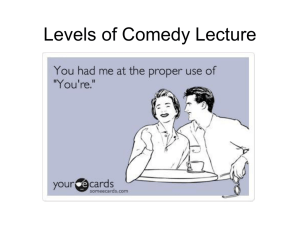
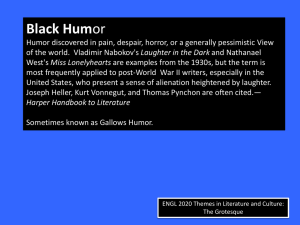


![[Lecture 19] studio system 2 for wiki](http://s2.studylib.net/store/data/005217793_1-c296c1b3b7b87d52a223478e417a702f-300x300.png)

